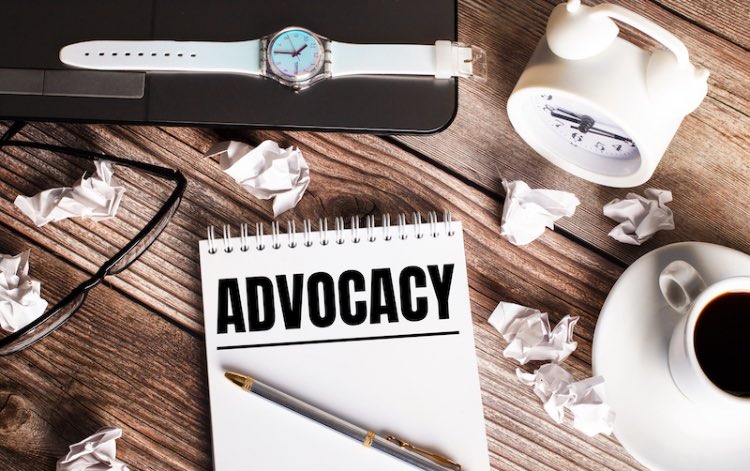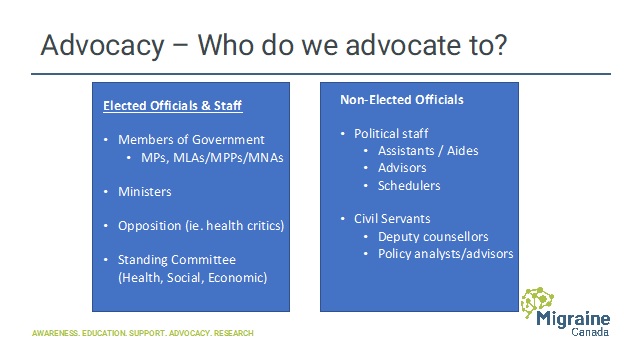Migraine Canada™ - Community Engagement & Patient Advocacy

Migraine Canada™ advocates on behalf of the 4.3 million (12%) of Canadians affected by migraine and headache related conditions. We are working closely with healthcare professionals and governments at all levels to engage & educate the public and government bodies. System-wide improvements in care, services and treatment are a priority for Migraine Canada™. All patients deserve affordable and equitable access to care, services and medication.
We are actively working to achieve our mission but need your help. Your voice is powerful and only you can share in detail how debilitating and serious this condition really is!
To improve the lives of Canadians with migraine and other headache disorders through awareness, support, education, advocacy and research
We believe that promoting knowledge and understanding of migraine and headache disorders will eliminate stigma and help decision makers and governments make educated choices about healthcare priorities and spending.
We are advocating for the community by:
- Sending letters and participate in meetings with all levels of government (Federal/Provincial/Territorial), including bureaucrats and politicians (decision makers).
- Sharing with Canadians how the healthcare system works; what is broken and how we can collectively influence change that will improve health outcomes.
- Informing & educating the media of issues in migraine care.
- Participating in campaigns and meetings on patient access policies across all levels government.
- Identifying opportunities to develop relationships with influential people to shape change.
- Submitting formal patient input to institutions (pCPA, CADTH, INESSS and provinces as appropriate).
Informing and educating insurers and employers about the impact migraine has on the workplace and associated costs of not effectively managing.
We need your help
Anyone can do this!
Make YOUR VOICE HEARD!
Your voice is powerful and only you can share in detail how debilitating and serious this condition really is!
Take the time to read through the information, the given tools and resources to feel confident. Anyone can be a successful advocate!

We need your help
Through our automated platform you can tell your provincial government representative about new medications to treat migraine must be included on all provincial formularies across Canada, including federal programs (NIHB and Veterans Affairs). Migraine patients have not had access to new, effective medications in decades. Our community deserves equitable access to medications and care.
Join thousands of Canadians across the country who are speaking out about access to medications, services, and care (including CGRP’s, Botox, gepants, etc).


We have made the process simple for you:
Step 1.
Read steps 2 through 5 first.
Step 2.
Once your postal code is entered, your local official contact information will pop up. Simply select the government official you would like the email to be sent to. Your options will be your local provincial representative, your federal representative and your Minister of Health. We encourage you to select all three.
Step 3.
We have designed the template letter to allow (and encourage you) to include your personal story/experiences.
Step 4.
In the closing (last) paragraph, if you are only writing to your “local” elected official and are requesting a meeting you can change the content to include this request on the template.
Step 5.
Choose one of our letter templates below
To help you get started, we prepared Letter Templates you can easily send to your government representatives by filling our online form. We have included the following subject letters. Hover the image below to select the one most relevant to your situation. We encourage you to write regularly and on as many topics that you are impacted by.
We currently have five choices:
- Current CGRP Patients
- Patients wanting to go on CGRP
- Past CGRP Patients
- Botox Patients
- Shortage of physicians and headache specialists
- Triptans Patients
Hover the image below to select the one most relevant to your situation.
Current CGRP Patients
Letter for people succesfully taking a CGRP medication.
Patients required to start CGRP
Letter for people being prescribed / recommended to move to CGRP medication.
Past CGRP Patients
Letter for people who have stop treatment.
Botox Patients
Letter for people taking Botox or wanting to take but can’t afford.
Shortage of physicians
Letter to request more physicians and headache specialists.
Triptans coverage
Letter for people taking Triptans or wanting to take but can’t afford.
Current CGRP Patients
Letter for people succesfully taking a CGRP medication.
Patients required to start CGRP
Letter for people being prescribed / recommended to move to CGRP medication.
Past CGRP Patients
Letter for people who have stop treatment.
Botox Patients
Letter for people taking Botox or wanting to take but can’t afford.
Shortage of physicians
Letter to request more physicians and headache specialists.
Triptans Patients
Letter for people taking Triptans or wanting to take but can’t afford.
Latest News!
Patient Advocates :
We will update this section with the number of letters sent.Number of patient advocates so far:
- # of current CGRP patients: 29
- # of patients required to start CGRP: 23
- # of past CGRP patients: 5
- # of Botox patients: 26
News :
We will also share information on how our efforts are going.
CGRP product currently covered :
We will update this section with informations on where medications are now covered by provincial programs.
Need More Info
About Self-Advocacy?
Most frequent questions and answers

Better Access to Medicine & Services
We recognize and understand drug plans, both public and private, are dealing with rising costs for medications and services. Because there have not been new medications to treat migraine in a very long time, there has not been a significant impact on budgets until now. We appreciate that fiscal responsibility is necessary and proactive innovative solutions are needed. We strive to offer alternative approaches to these critical and growing issues when we meet with decision-makers who are dealing with the rising costs of medications, care, and services. We encourage governments to collaborate with us to understand the environment and adopt best practices to deliver programs to ensure positive health outcomes for Canadians are realized.
In our messaging with government and decision makers, we strive to ensure decisions are made with a clear understanding of potential consequences. What happens when people don’t access safe effective and tolerable medication. Governments need to be held accountable for the programs and plans they administer and impact not only to the healthcare budget but to other budgets and the constituents living in their province.
Why Take Action?
People with migraine and headache conditions are the experts on living with this disease. No one can share your experience and articulate it better than you!
The voices of people living with, or impacted by, migraine and headache conditions are the most important to be heard. It is the people, like you, living with chronic disease who are directly affected by health policies. As a person living with a chronic disease, you can provide important perspectives that, too often, are not heard resulting in uninformed decisions being made.
It is the individuals who are personally impacted by migraine and headache diseases who first hand experience the strengths and weaknesses that exist in our Canadian healthcare system. It is you who navigates the healthcare system daily. It is you who knows about the importance of being able to access the most effective medicines. It is you who knows how your quality of life — your ability to work, care for your family, and participate in society is affected.
It is important that people who are personally impacted participate in
self-advocacy. The term self-advocacy, which means speaking up for oneself and one’s interests, is used as a name for civil rights movements and mutual aid networks for disabled people. Look for ways to have your voice heard – your personal story heard. There are several ways to be heard and we encourage you to take every opportunity available to advocate for change to improve healthcare and services impacting your life. In addition to writing emails, you can advocate to government (provincial and federal) through the media (ie. letters to the editor, television, or radio interviews). Your role as an advocate begins with being proactive, knowledgable and empowered. Self-advocacy is a way of reaching out to others and explaining your condition and experiences to family, friends, co-workers, employers, and even strangers. For many it is rewarding and therapeutic. Self-advocacy will help chip away at eliminating the stigma and discrimination people like you encounter daily.
Discrimination against people diagnosed with migraine and other headache conditions occurs on many different levels — from friends thinking migraine is a bad headache and will go away if you take Tylenol or Motrin; to emergency room personnel being unsympathetic; to government denying reimbursement of effective treatment options. Together we can stop the stigma and make people understand the facts.
Many people living with migraine face discrimination at work. There is a stigma attached to chronic diseases like migraine that discourages employees from disclosing their medical condition to colleagues and employers. Many employees are worried that disclosure could have negative consequences like loss of career opportunities or perhaps termination of employment.
Providing proper treatment and care for people with chronic diseases like migraine makes financial sense. We know that government is always looking for solutions that make financial sense, and we believe that creating a healthcare system that provides the best possible treatment and care to people living with chronic conditions like migraine makes economic and social sense.
We hope you will join us to make sure that the decision makers and people who have influence are receiving the facts.
As mentioned above, it is the people living with or impacted by chronic conditions like migraine who are, and must be, your own best advocate. It is you who knows better than anyone else what it is like to live with migraine. It is through sharing your personal story and experience that you can help your family, partners, work colleagues, community leaders and elected officials understand how their actions impact individuals like yourself.
Learning to advocate can be difficult for many people. It isn’t something that comes naturally for most people. Everyone can become an effective advocate over time. It’s important to realize you have the most important and valuable tool you need – your personal story, your personal journey, and your personal experiences. No one understands migraine better than those who live with it every day. You are the expert. It is through your sharing firsthand lived experiences to the public, media and elected officials you will play a critical role in shaping legislation and policies that affect the community.
Expanding access to medications, care & services is one of Migraine Canada™’s policy priorities.
As a community, together with a robust and coordinated campaign, we can achieve all of our shared goals. Working collaboratively, and diligently, we can improve migraine care in Canada.
Migraine Canada™ has developed a toolkit with information that will help you self-advocate. It’s important to remember that anyone can become an effective advocate. We have provided resources to help you identify the key stakeholders and influencers in your region and how to communicate to them.
It doesn’t matter which channel you decide to use. You can choose to do more than one initiative. Choose the channel that feels most like you and what you are comfortable with. What’s important is that you speak up for yourself and the broader migraine community.
There are several ways you can advocate (click on the option for more information):
- Send emails
- Make telephone calls
- In person meetings
- Use social media
- Use traditional media
Develop your key messages
Carefully frame your messages:
- Develop 3 key messages that explain the salient points of your issue in simple language
- Request a meeting with your representative or call to action
- Each message should be 25 words or less
- Be clear, compelling, concise, and consistent
- Have someone read your email/letter before sending
- If you are meeting in person, practice presenting your 3 key messages
Determine your “one” ask
Define what your objective or goal is:
- ONE ask – you are going to ask for what you need (this cannot be a list. It must be one thing only)
- You may need to make a choice and prioritize what is the most important issue you have right now.
- Build your “ask” into your “call to action” key message to help ensure it is delivered
- Explore opportunities that might make your “ask” timely (is there an election, are medications currently being reviewed or negotiated).
Preparation & Follow-up
- Request a meeting or expectation of a response to your email with your representative by email (or letter) and follow-up by phone or another email.
- If you have a meeting, do your research, know your issue, and try to learn about your Gov’t representative. You may have something in common.
- Prepare a “leave behind” (Migraine Canada™ has credible information you can download or refer to.)
- Take notes to use when following up
- Send a thank you letter and follow up on any information
Tips for a productive meeting:
- Develop a connection (maybe something you have in common)
- Ask if they know about Migraine and find out their connection (if any)
- Assume they know nothing, and you are the expert
- Introduce your issue(s)
- 30 second pitch of the issue
- Present a solution – have ONE ask

Together, our voices can influence policies that have the potential to affect people with migraine and their loved ones. We look forward to advocating with you.
Remember – If you have any questions, don’t hesitate to reach out to us at [email protected]

